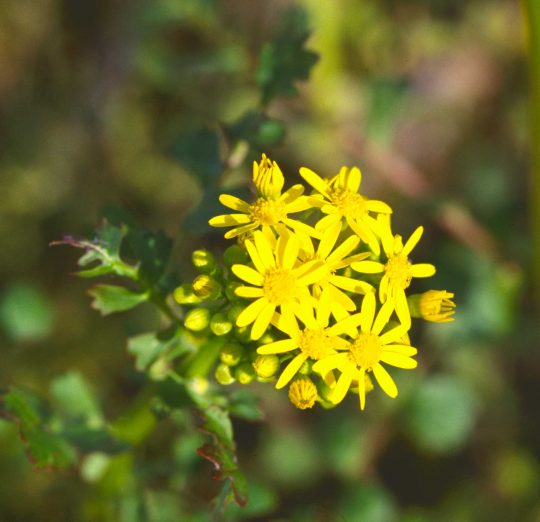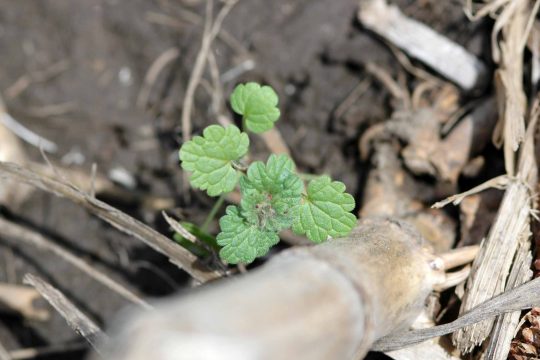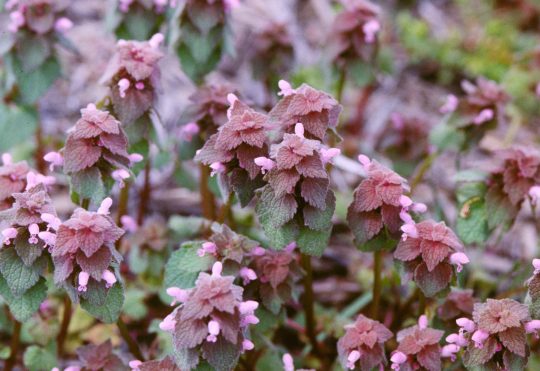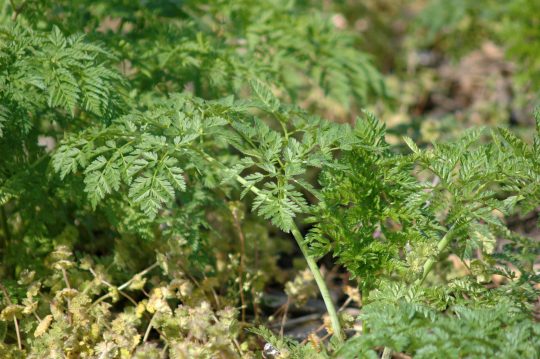By Aaron Hager, Associate Professor
Ample soil moisture and warming temperatures are promoting rapid growth and development of many early-season weed species. Most weeds currently growing in fields emerged last fall and successfully overwintered (winter annuals, biennials or perennials), but several early-season summer annual species recently have emerged. Existing weed vegetation should be controlled before planting by utilizing tillage, herbicides, or a combination of tactics so the crop can become established under weed-free conditions.
Field scouting to identify the weeds present and their relative densities will provide the information needed to tailor a burndown herbicide program for any particular field. Many different weed species can be present in any particular field, and accurate identification sometimes can be challenging. Following are brief descriptions and color photographs of several weed species common to Illinois fields at this time of year.
Annual bluegrass is a shallow-rooted grass species that often roots at the lower nodes. Plants grow to about 12 inches tall and often have begun to flower by the time of crop planting. Leaves lack auricles and possess a membranous ligule. Leaf blades are glabrous on both surfaces and keeled with sharp-pointed tips.

Annual Bluegrass
Over a dozen species of buttercup exist in Illinois, which can make accurate identification a bit challenging. Smallflower buttercup is one species that can be found across much of the state. Its lower leaves are rounded and broad with toothed margins, generally bright green in color and borne on long petioles. Upper leaves are deeply lobed with much shorter petioles. Flowers have yellow petioles and seeds are contained within a cone-shaped structure known as an achene.

Buttercup

Buttercup inflorescence
Butterweed (a.k.a. cressleaf groundsel) is a winter annual species that produces bright yellow flowers in later spring. The plant overwinters in a rosette stage, and “bolts’ in the spring to produce a hollow stem that is green or red in color and smooth to the touch. From a distance the yellow flowers of butterweed resemble those of yellow-flowered mustard species, but butterweed actually is not a mustard species.

Butterweed (a.k.a. cressleaf groundsel)

Butterweed inflorescence
Common chickweed often forms very dense mats of vegetation that can make planting difficult. Common chickweed has a shallow, fibrous root system and a stem that branches extensively and often roots at the nodes. Leaves are small, opposite and pointed at the tip. A perennial chickweed species, mouseear chickweed, can be differentiated from common chickweed by the dense hairs covering its stem and leaf surfaces.

Common chickweed

Mouseear chickweed
Dandelion is a simple perennial species that forms a large, often deeply rooted taproot. The leaves have irregular margins, are often deeply lobed, and form a basal rosette. The flower is large and yellow.

Dandelion
Field pennycress begins as a basal rosette of leaves, then produces an erect flowering stem that is smooth and tends to smell unpleasant when bruised. Leaves on the upper stem are alternate and sessile about the stem with earlike projections, and either entire or slightly toothed margins. Field pennycress is one mustard species that produces white flowers consisting of four petals. Other mustard species that produce white flowers include shepherd’s-purse and Virginia pepperweed. The most common yellow-flowered mustard species in Illinois fields is yellow rocket.

Field pennycress

Field pennycress inflorescence

Shepherd's purse

Shepherd's purse inflorescence

Virginia pepperweed

Mature Virginia pepperweed

Yellow rocket

Yellow rocket ionflorescence
Henbit and purple deadnettle are close botanical relatives; both exist as winter annuals and both have square stems. Henbit is more commonly found throughout Illinois, while purple deadnettle appears more often in about the southern half of the state. The lower leaves of henbit are attached to the stem with petioles while the upper leaves grasp the stem (i.e., lack petioles). The upper leaves of purple deadnettle, however, are attached to the stem with petioles, are more triangular than those of henbit, and are less deeply lobed.

Henbit

Henbit

Purple deadnettle

Purple deadnettle
Fall-emerging horseweed (a.k.a. marestail) plants form a basal rosette that represents the plant’s overwintering stage. In the spring, the main stem elongates rapidly. Leaves, very numerous and hairy with toothed margins, alternate around the stem and become progressively smaller in size toward the top of the plant. The leaves on mature plants lack petioles, and have entire or slightly toothed margins. As the plant matures, leaves toward the base of the plant deteriorate and fall off the stem.

Horseweed (a.k.a. marestail)

Horseweed inflorescence
Kochia is one of the earliest-to-emerge summer annual weed species. Its leaves are opposite, simple and very hairy. Stems are erect and often become grooved as the plant ages. Mature plants can vary in color from green to red.

Kochia
Poison hemlock is a biennial species becoming increasingly common in reduced-tillage environments. Leaves are arranged alternately on the stem, triangular in outline, four to five times pinnately compound (fern-like), without hairs and borne on petioles. Basal leaves have a long petiole, while upper leaves have much shorter petioles. Stems (produced during the second year) are erect, much branched, smooth (without hairs), and hollow except at the nodes. Stem color is light green and lower portions of the stem are spotted or streaked with red or purple blotches. The inflorescence of poison hemlock is a compound umbel consisting of multiple white flowers, each flower bearing 5 petals.

Poison hemlock

Poison hemlock
Prickly lettuce is a winter or early summer annual with a large taproot and stem that grows up to 6 feet tall. The leaves are large and coarse with prickles along the margins. Older leaves also have a row of prickles along the underside midvein. The stem, roots and leaves exude a milky sap when injured.

Prickly lettuce

Prickly lettuce
Speedwell species are generally considered winter annuals, although some perennial species exist. Some species grow close to the ground and form dense mats of vegetation, whereas other species grow more upright. Leaf shape varies by species, but most speedwell species have lower leaves that are opposite and upper leaves that are alternate.

Speedwell
Wild carrot is a biennial species that most often occurs along the edges of reduced-tillage fields. Typical of biennial species, its first year of growth occurs as a rosette of leaves followed by rapid stem elongation and maturation during its second year. Some confusion may exist when trying to differentiate between poison hemlock and wild carrot. Both poison hemlock and wild carrot are biennial species that produce an umbel inflorescence, but poison hemlock is a much more toxic plant than wild carrot. Some characteristics of difference between poison hemlock and wild carrot include: plant height (poison hemlock may reach 6 to 10 feet in height at maturity, wild carrot rarely exceeds 4 to 5 feet at maturity); stem coloration (poison hemlock stems have red to purple blotches, wild carrot stems have no such coloration) and hairs (poison hemlock has stems with no hairs, wild carrot has stems with bristly hairs); flowering time (poison hemlock flowers mid-late spring, wild carrot flowers later in summer); the pungent odor of poison hemlock foliage, and the hairy leaves of wild carrot.

Wild carrot

Wild carrot
Two members of the smartweed family that emerge during the early spring are prostrate knotweed and Pennsylvania smartweed. Both species (as well as most members of the Polygonaceae family) have swollen nodes covered with a membranous sheath called an ocrea.

Prostrate knotweed

Smartweed





